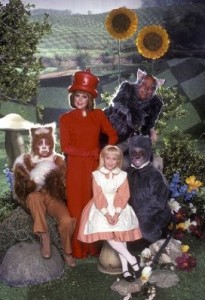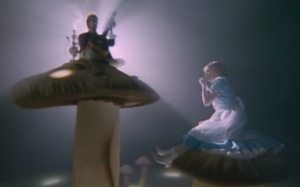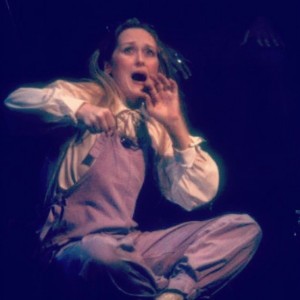
In these posts we will be doing our best to provide a preliminary answer to some of the questions asked at last week’s Mad Hatter Tea Party. Please note that these answers are not intended to be exhaustive: rather, they are an illustration of how someone might start to research using the database, and we hope that they will encourage and enable readers to continue the process on their own.
Question # 1 – How does war or international emergencies in which the U.S. is engaged become an influence on the demand for Cinderella versus Alice in Wonderland?
Note here: I will not discuss historical factors affecting Cinderella in this answer, because two other members of BYU Fairy Tales have written presentations on the subject. Links to those presentations will be forthcoming.
This question asks how historical events become associated with tales/influence their popularity, so I started my research by looking at the fairy tales over time infographic for Alice in Wonderland (https://fttv.byu.edu/#visualizations). Looking at the graph in raw data, there are several spikes in Alice allusions, the most dramatic of which is in the 1980s and from 2013-14.* This time frame suggests that while use of Alice may not be completely separate from wartime stressors, that is not the only or the most important indicator. I did a little digging, and it turns out there are a variety of factors that have combined over the past few decades to make Alice in Wonderland one of the most frequently referenced literary fairy tales in television.

Alice in Wonderland and Through the Looking Glass were written by Lewis Carroll (Charles Lutwidge Dodgson) and published in 1865 and 1871, respectively. The copyright on Alice expired in 1907, which meant that both books were, like fairy tales, in the public domain at the inception of television. Whether because of the book’s popularity or its lack of copyright, the story has been reproduced and referenced many times on television from the very beginning. A small uptick in Alice references appears after 1950 when Disney released its animated version. However, Alice became culturally significant in a different way in the 1960s when Jefferson Airplane’s song “White Rabbit” associated the story with LSD and drug-induced hallucinations. Disney profited from this association, circulating a 16 mm version of their Alice film and marketing it as a “phantasmagoric experience.” The association between Alice and drugs continued to become more culturally recognizable throughout the 1960s and 1970s.
At the same time, Alice was gaining status as a work of literary significance. In 1981, Meryl Streep starred in a musical version of the story for the New York Shakespeare festival. The performance was televised in 1982. While I was not able to find any sources discussing Alice’s particular popularity during this decade, it seems likely that the wide literary and cultural recognition of Alice made it useful story with which to explore the cultural tension of the United States in this period. An example is this clip from the 1985 miniseries Alice in Wonderland, expressing the terror Alice feels at being trapped in a psychedelic hallucination: https://www.youtube.com/watch?v=g7dxhbHAGRE.

In the books and in the clip from the miniseries above, her separation from Wonderland is both good and bad: she sees magical and wonderful things, but also experiences confusion, fear and a sense of loss. This ambiguity parallels the struggle of 1980s Americans to reconcile their feelings about drug culture’s association with both freedom and destruction. Further research could determine more certainly why Alice was such a powerful story for audiences during this decade, but based on my preliminary research, the 1980s upswing is a result of both growing acceptance of the book as an important literary staple and the story’s association with drug culture.

In recent years, the cultural relevance of Alice has continued to expand, and has made its way into fairy tale mash-ups and anthologies. The searchable teleography ( https://fttv.byu.edu/#datatable ) makes it clear that the spike in references to Alice from 2013-2014 is almost entirely due to “Once Upon a Time in Wonderland,” the ABC “Once Upon a Time” spin off that combines the stories of Alice in Wonderland and Aladdin’s Genie.
By examining the references in the teleography and this network graph of tale types and TV shows, it becomes clear that Once Upon a Time in Wonderland is unique. I didn’t realize this until writing this blog post, but Alice’s story has not often been combined with references to other fairy tales, whether in an episode or in a series. While her story has long been considered fantastic, it has not, until this series, been treated as a fairy tale in television. Continuing research will be needed to determine if this association will continue beyond ABC’s series: whether Alice has, at least in some people’s minds, truly become a fairy tale.
*The current visualizations available on fttv.humwp.byu.edu do not yet reflect this upswing in the database, as we are in the process of updating them with recent information added to the database.
